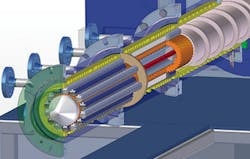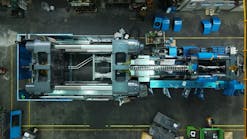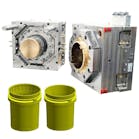Suppliers of multiple-screw extruder systems designed for compounding or melting and homogenization have reconfigured their equipment to consolidate processing steps or process a range of materials better. Another supplier of twin-screw units enhanced its software for designing screw and barrel configurations.
DIRECT FEEDING FORPVC FORMULATIONS
Entex Rust & Mitschke GmbH, Bochum, Germany, recently introduced a single-stage planetary roller extruder that eliminates potential processing and material-quality issues associated with more traditional planetary extruder configurations, allowing the unit to directly extrude a finished product rather than a dry blend.
The typical role of a planetary roller extruder is to premix ingredients used in a PVC formulation, which are then plasticized and homogenized by an extruder, said Michael Batton, overseas sales director for Entex, which is represented in the U.S. by Triad Sales LLC, Greer, S.C.
It is common practice for PVC powder, stabilizer, plasticizing aid, color paste and softener to be plasticized, masticated, degassed, mixed and homogenized into a PVC dry blend using a planetary roller extruder. That premixed dry blend is fed by a stuffer into an extruder to be pelletized or made into product, Batton said.
"The thermal sensitivity of PVC prohibits processing steps involving intensive shearing or high temperatures, since overheating significantly reduces product quality. A planetary roller is able to plasticize and homogenize compounds while introducing low shear loads. Combined with its high tempering capability, it can handle challenging and sensitive compounds," said Bratton. The downside of this necessary step is that premixing takes a lot of time and energy.
A conventional two-stage planetary roller extruder for PVC processing consists of a feeding section and a processing section. The feeding section is a single-screw extruder where the ingredients for the PVC formulation are introduced. The processing section consists of a barrel, around which is a large, central spindle featuring an array of gear teeth and a number of smaller spindles — each with an array of gear teeth — arranged around the central spindle. The central spindle is a driven mechanism that causes the smaller spindles, or planetary gears, to move around it. The central spindle and the barrel have a controllable zoned heating and cooling system to promote melting.
The extrudate moves through the intermeshed teeth of the central spindle, the planetary spindles and the barrel. "The big surface area allows high heat transfer rates between the central spindle, barrel and material, resulting in precise temperature control," said Bratton.
Entex said material and processing problems can occur in a conventional planetary roller extruder when the material moves from the single-screw feeding section into the central gear of the planetary roller extruder. Sticky and hard-to-process materials can be difficult to handle in the feeding zone, leading to high levels of shear and mechanical mixing rather than conveying. Sticky materials may require more energy to convey in the feeding section, and more frequent cleaning and maintenance may be needed due to incomplete conveying or melting, said Bratton.
Entex's new single-stage planetary roller extruder is designed without the single-screw feeding section. The modular design of the new single-stage unit eliminates the need for a premixing device, allowing the user to introduce the ingredients for the PVC formulation directly into the planetary roller section. The direct feeding and compounding unit also reduces the space required on the plant floor, is simpler to operate and saves energy, said Bratton.
Instead of creating a PVC dry blend, the planetary roller extruder makes a material that can be directly extruded into a pelletizer or actual product. "The customer is able to produce a thermally homogenous extrudate, and is able to reduce the starting/processing times to 20 percent" of conventional systems, said Bratton.
Entex has conducted multiple trials with various configurations of its planetary roller extruders and has processed a multitude of PVC formulations. The company has developed and continues to test several direct-extrusion configurations based on its TP-WE line of planetary roller extruders. It offers a modular planetary roller extruder that incorporates four modules and has a process length of 5,600mm, with a drive capacity of 1,000 kilowatts and production capacity of 13,200 pounds per hour.
Other designs include a configuration with two planetary roller sections. A gear pump doses the materials into the first planetary section for low-shear melting and homogenization. The melt passes through a dispersion ring for increased dwell time and homogenization, then into the second planetary module. The material passes through a cutting ring before exiting the unit. Entex employs a vacuum chamber that improves material discharge and helps to remove volatiles.
Entex also offers a unit with a single planetary module. Entex can adjust the diameter of the dispersion ring and knife ring, and can customize the central and planetary gear spindles to handle a wide range of compounding processes, including non-PVC formulations, said Bratton. "Materials can now be pelletized which could not be pelletized before," he said.
EXTRUDER WITH MULTIPLESCREWS UPDATED
Technovel Corp., an Osaka, Japan, manufacturer of compounding extruders, has updated its WDR series of multiscrew extruders that are designed to offer better processing capabilities than single- or twin-screw units, said Sugiya Umeda, VP of sales.
The WDR series is designed for processors requiring the production capability of a long compounding extruder in a small footprint. The WDR series is configured with four or eight intermeshing, co-rotating screws. A processor operating an extruder with a 15mm diameter screw and a 150 to 1 L:D ratio could achieve similar output by switching to a design featuring four 15mm diameter screws, with each screw having a 30 to 1 L:D ratio, said Umeda.
Technovel has offered the WDR in a four-screw configuration (called Quad Screw) since 2000, and has offered an eight-screw design (the Octa Screw) since 2008. The company improved the WDR line to reduce heat generated from the material in the processing section, and also has improved material feeding and venting, allowing for more stable and precise extrusion. Enhanced screw design and other upgrades offer the possibility for extended material residence time where needed, better material dispersion, improved energy savings and space savings.
Technovel offers the WDR series in a choice of 15 screw diameters from 6mm to 134mm and lengths from 15mm to 150mm. Users can select from three types of screws, which can be designed to operate at standard screw speeds from 60 to 100 rpm, or at higher speeds up to 6,000 rpm, said Umeda.
UPDATED SOFTWARE TARGETSSCREW/BARREL CONFIGURATION
KraussMaffei Berstorff GmbH, Hanover, Germany, last month updated its ScrewCon software program, which allows the company's customers to design screw and barrel elements for its twin-screw extruders. The 3.0 version features a new user interface and updated features.
ScrewCon 3.0 has a library of about 2,000 screw and barrel elements that users can choose from, which correspond to different sizes of twin-screw machines in the company's ZE BluePower, ZE UTi, ZE UTXi and ZE Basic models, said Andreas Madle, who is responsible for process-engineering development.
The proprietary and intuitive Windows-based ScrewCon 3.0 software can be used to design the setup of twin-screw extruder processing sections, KraussMaffei Berstorff said. Features include a clear and true-to-scale visualization of screw and barrel elements that substantially reduces the time required to prepare the configuration. The software displays selected screw and barrel elements directly below each other, which allows the user to see instantly whether the selected elements match. The software also allows the user to precisely position the selected element relative to the barrel housing opening. An inventory-management feature lets users view the available stock of elements within their own company's inventory, and can thus determine if the desired configuration can be implemented immediately.
The ability to individually configure each screw in a twin-screw setup is another enhanced feature. ScrewCon 3.0 provides simultaneous display of the right and left screws. Each screw can be individually designed with different elements, such as flight characteristics, according to KraussMafffei Berstorff. System visualization helps to avoid installation errors when configuring the left and right screws with different screw elements, the company said. KraussMaffei Berstorff is represented in the U.S. by KraussMaffei USA, Florence, Ky.
Mikell Knights, senior correspondent
Contact:
KraussMaffei USA, 859-283-0200, www.kraussmaffeigroup.com
Technovel Corp., 81 6-6964-1230, www.technovel.co.jp
Triad Sales LLC, 864-879-9300, www.entex.com
Plastics Hall of Fame seeks nominees
Amcor, Berry Global will merge








